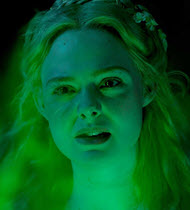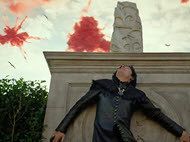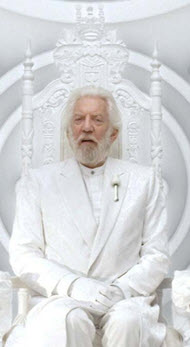Maleficent: Mistress of Evil
 for intense sequences of fantasy action/violence and brief scary images.
for intense sequences of fantasy action/violence and brief scary images.
Reviewed by: Charity Bishop
CONTRIBUTOR
| Moral Rating: | Average (somewhat offensive)—with strong caution for younger ones |
| Moviemaking Quality: |
|
| Primary Audience: | Adults Young-Adults Teens |
| Genre: | Dark-Fantasy |
| Length: | 1 hr. 58 min. |
| Year of Release: | 2019 |
| USA Release: |
October 18, 2019 (wide—3,700+ theaters) DVD: January 14, 2020 |








Modern revisionist fairytales
Dark Fantasy

How do you feel about the idea of a nice girl having a trusted, guiding and powerful “dark fairy godmother” that looks quite demonic and has done bad things?

By the end of this film, it becomes apparent that Maleficent is the most awesomely powerful being in that world. In our world, the triune God is the all-powerful One.
Use of fantasy magic in films
Is Satan A REAL PERSON that influences our world today? Is he affecting you? Answer
SATAN’S STRATEGY—What is one of Satan’s most successful strategies in dealing with followers of Christ? Answer
Who is SATAN? How is he the enemy of God and all people? Answer

Strong HUMAN EMOTIONS play a big part in this film. Given the sinful nature of humans, in what ways can our strong emotions be dangerous and lead us down wrong paths in life and into sins—especially the emotions of young people?
What is WISDOM?
Self-sacrifice for others
LOVE—a feeling, an emotion, or an action? Answer

ROYALTY of the Bible, both the good and the corrupt: kings / queens / princes
Compare human kingdoms to The Kingdom of God—What, when and where is it? Answer

Learn about real LIGHT and DARKNESS in our world, the way God sees it
Why does Satan frequently attempt to confuse people about the true nature of darkness and light?
The Bible warns that Satan masquerades as an “angel of light” to deceive humans, and that the evil false teachers he inspires similarly masquerade as good people (2 Corinthians 11:13-15).


Today, this convention is being deliberately reversed. Black (darkness) represents good, and white (light) represents evil. White identifies those people that the filmmakers want to be revealed as hypocrites, arrogant deceivers, cruel and dangerous. Why are Liberal Hollywood producers increasingly doing this?



| Featuring |
|---|
|
Angelina Jolie … Maleficent Elle Fanning … Princess Aurora Harris Dickinson … Prince Phillip, crown prince of Ulstead and son of King John and Queen Ingrith Michelle Pfeiffer … Queen Ingrith Robert Lindsay … King John Imelda Staunton … Knotgrass Juno Temple … Thistlewit David Gyasi … Percival Ed Skrein … Borra Chiwetel Ejiofor … Conall, a dark fey Sam Riley … Diaval, a raven who changes into human form Lesley Manville … Flittle Warwick Davis … Lickspittle Kae Alexander … Ini (desert) See all » |
| Director |
|
Joachim Rønning |
| Producer |
|
Roth Films Walt Disney Pictures See all » |
| Distributor |
Prequel: “Maleficent” (2014)
It is five years since the Dark Fey Maleficent (Angelina Jolie) regained her wings and defeated King Stefan. Having given up her human crown, his daughter Aurora (Elle Fanning), now rules the Kingdom of the Moors (faerie folk). She is an honest, fair and just ruler who hopes one day humans and faeries can live in harmony.
Prince Philip (Harris Dickenson) believes it is time to unite their kingdoms and proposes marriage. She accepts, though dreads telling her adopted mother. Maleficent does not welcome the news. Humans have stolen faerie folk out of the Moors in recent months, and Philip comes from a human kingdom, after all.
Philip’s father King John (Robert Lindsay) is ecstatic for his son and prays this will bring much-longed-for peace to their nations. His mother Ingrith (Michelle Pfeiffer) invites Aurora and Maleficent to the castle for a special dinner in the spirit of unity. But she pushes Maleficent too far in her talk of Aurora having a “real” family.
Maleficent loses her temper. She blasts magic through the room. The king collapses. And since she has a reputation for casting the curse that put Aurora to sleep, everyone believes her responsible. In fact, Ingrith believes it is enough to start a war…
“Maleficent: Mistress of Evil” has themes of redemption, loyalty, forgiveness, self-sacrifice, tolerance and acceptance. The parallels between the faerie folk and the humans could easily take place in our world, between different races, religions, creeds, and political beliefs. The villain manipulates the public to stir up hatred and division, then revels in the chaos caused by war. Their motive stems from a seething resentment born of their childhood, which they have never forgiven. (This character is a good illustration of why Scripture tells us not to let the sun set on our anger.)
Racial tensions arise between Maleficent and the humans, with both sides fearing and hating the other. She discovers more Dark Fey of her own kind. There is a warmonger and a peacemaker among them. One believes the only way to stop the violence is by killing the humans; the other tries to convince her that kindness, forgiveness, and unity is the only way to heal the rift and move forward. This is a belief shared by the film’s secondary heroine, Aurora, and also her prince. Both show kindness, forgiveness, courage, and a determination to heal the brokenness caused by decades of intolerance and fear.
“Blessed are the peacemakers, for they will be called the children of God.” —Matthew 5:9.
Though Aurora is sweet, she also has her flaws—she tries too hard to “adapt” to her new family, showing the dangers of sacrificing what you know is right for external approval. Fortunately, she learns her lesson by the end and is once more true to her values, but this is an important thing for young people to think about as they enter the world. They may face pressure to walk away from their beliefs and values and conform. Her desire to please others makes her relatable, and she truly comes into her own in this film.
Four separate times, characters sacrifice their lives for their friends. They know it will kill them, but they do it out of love. One character’s sacrifice allows another to have a second chance at redemption. Spoiler! There is also a resurrection from death, although it’s because the character is descended from a phoenix. The symbolism of sacrifice bringing rebirth is strong. I enjoyed how the story showcased and used the theme of love (between friends, strangers, mothers and children, and a young couple) in a deep, meaningful way.
All symbolism aside, the magic is like the first film. Maleficent blasts soldiers out of the room with her Fey powers and transforms her raven friend Diavel (Sam Riley) into different forms. She turns someone into a goat as punishment. The villain uses Maleficent’s spelled spindle to cast a curse. The flowers over faerie graves glow with an otherworldly magic. The Dark Fey mourn a peaceable faerie who is dying and perform a ritual to help him pass into the earth as he breathes his last breath.
Maleficent is filled with rage at his death, and goes on a rampage. There is no bad language or sensuality (a few of the gorgeous costumes reveal cleavage or bare stomachs), but a lot of violence when tensions erupt into a war between the two nations. Winged-Fey toss humans aside or cast them to their deaths; vines snatch them up and hoist them in the air. The king mentions two deaths in the outer reaches of the kingdom. The Fey suffer the worst casualties; the villain uses a combination of faerie dust and iron to dissolve them in explosions of red dust. Some faeries disintegrate into ash; others revert to their original non-magical form (trees and flowers). Iron bullets and bolts out of crossbows hit, maim, and kill faeries, including a traumatic sequence when Maleficent falls into the river and almost drowns. Most teens and adults will find the violence tame, but the lengthy battle scenes, peril of important characters, and even Maleficent’s sinister appearance may scare small children.
On an artistic level, this film is beautiful. The costumes are stunning. The interiors are magnificent. The various worlds are unique and memorable. It is lovely to watch, due to all the vibrant colors and striking visuals.
Racism
The film depicts hatred between two races, and a character purposely STIRS UP DIVISION between them. Some people today are doing the same for political advantage (power).
“The old racism is obvious and unacceptable. However, the new liberal racism is camouflaged as a cure when it is in fact a far more deadly strain of the disease.” —E.W. Jackson Sr., American Thinker
RACISM—What are the consequences of racial prejudice? Answer
“Tolerance” and “acceptance”
Actor Sam Riley, who plays the shape-shifting raven, says that “Mistress of Evil” presents “important messages…about tolerance, acceptance, openness and friendship between races or species…”
True followers of Christ know that we are not to simply tolerate others, but to LOVE them. We are to love all people, even love our worst enemies. Hate sin, hate evil, but do not hate people—love them. What is LOVE, for a follower of Christ? Answer
THE NEW TOLERANCE—It’s “politically correct,” but does it hold dangers? Answer
Does God call us to be “Politically Correct”? Answer
Eco-Warriors
The film portrays most humans as greedy abusers of Nature and inserts the DARK FEY as “eco‐warriors,” a band of dark winged-creatures with intimidating horns and abilities that visually may bring to mind fallen angels. These Dark Fey are presented as connected to Nature and the environment and determined to protect it—“fearless, heroic and kind… advocates of peace” who provide the kind princess with protection and hope. What political and spirtual messages are being promoted with this portrayal?
Political symbolism
From a secular point of view, there is plenty of symbolism also in its desire for inclusion, tolerance, and open borders being an assault on nationalism and the Trump regime. The villains are intolerant of the “other kind” (foreigners across the river) and do not want to mix with them. They use former conflicts as justification for their hatred and prejudice (“they flourished while we starved; I wanted to take what we needed, but my foolish father advocated for peace”). The villain spreads lies to incite the public and support her position (which is war).
The rounding up, experimenting on, and massacring of fae characters is a throwback to the Holocaust gas chambers, with them being disintegrated to prove how a toxin works and locked inside a CHURCH and subjected to red gas.
Humans often stray into the fae lands and pluck flowers or take creatures, in an environmentalist nod. Humans are the destroyers or innocence and beauty, and the Fey of Maleficent’s kind want to retaliate with violence.
The rituals of Maleficent’s kind are pagan and suggestive of a circle of life belief system—the Fey die and put their power into the earth, which brings forth more Fey kind.
The first film was lighter and less traumatic for sensitive viewers than this one. The battle scenes are long and intense, with many casualties. The loss of so many innocent, cute faerie creatures will be frightening and sad for children, including one favorite sacrificing her life for her friends. (Though she turns into a flower when she “dies,” the loss will still be hard for kids.) Characters such as Aurora are threatened, locked in their chamber, manhandled, have crossbows fired at them, climb out of windows, fall from great heights, and are tossed off towers.
Maleficent’s wrath topples buildings, transforms Diaval into a bear (he sets about knocking people over and later apologizes for “anyone I may have mauled today”), and sends humans careening through the air. I realized only after the fact that the film is rated PG and not a more appropriate PG-13. Please use caution when deciding whether to take kids; the lower rating is misleading, given the last 20 minutes are intense battle scenes and/or include attempts to eradicate an entire race.
My favorite author, C.S. Lewis, said, “Someday, you may be old enough to read fairy tales again.” For many generations, these stories have been vessels to tell moral lessons of goodness, self-sacrifice, and heroism. Though “Maleficent” has plenty of darkness, it offsets it with love of the purest kind.
“Greater love has no one than this, that someone lay down his life for his friends.” —John 15:13
- Violence: Moderately Heavy (Extremely Heavy for a PG-rated film)
- Occult-like elements: Moderately Heavy
- Nudity: Minor
- Sex: Minor— engaged couple kisses
- Profane language: None
- Vulgar/Crude language: None
See list of Relevant Issues—questions-and-answers.


While not the worst it could have been, the movie was boring, and I felt sleepy half the time. If you skip this movie, I promise you are not missing much, if anything. (John 3:16, Romans 10:9, Acts 16:31)
Moral rating: Average / Moviemaking quality: 4½
PLEASE share your observations and insights to be posted here.










My kids, 12 and 14, really enjoyed it as did I. I recommend it. It’s visually entertaining and has some great positive themes throughout.
My Ratings: Moral rating: Average / Moviemaking quality: 5